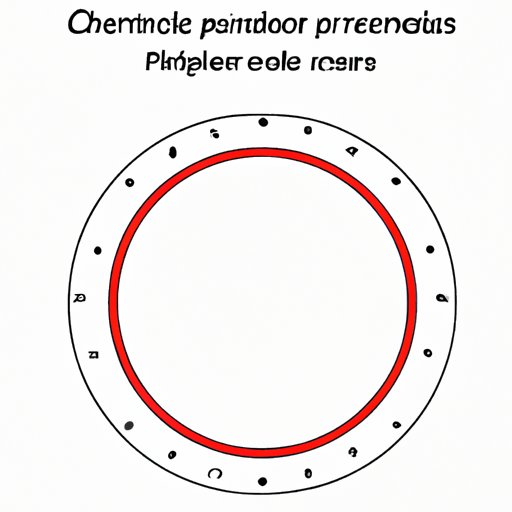Introduction
Are you struggling to solve problems related to the perimeter of a circle? Whether you are a student or a professional, knowing how to calculate the perimeter of a circle is a vital skill. This article will provide a step-by-step guide to help you understand and solve problems related to finding the perimeter of a circle. We will provide real-world examples, explain the relationship between diameter, circumference, and perimeter, and even cover techniques for solving problems with irregular circles. So, let’s get started!
Step-by-Step Guide to Finding the Perimeter of a Circle
Before we get started calculating the perimeter of a circle, let’s first define some essential terms. The radius of a circle is the distance from the center of the circle to its outer edge. We use the symbol ‘r’ to denote the radius.
The formula for calculating the radius of a circle is:
r = d/2
where ‘d’ is the diameter of the circle.
The circumference of a circle is the distance around the outer edge of the circle. We use the symbol ‘C’ to denote the circumference.
The formula for calculating the circumference of a circle is:
C = 2πr
where ‘π’ is a mathematical constant equal to approximately 3.14.
Now that we’ve covered the basics, let’s jump into the steps to calculate the perimeter of a circle.
Step 1: Find the radius of the circle, either from the problem statement or by finding the diameter and using the formula above.
Step 2: Use the formula for the circumference of a circle to solve for ‘C’.
Step 3: Once you have the circumference, the perimeter of the circle is simply the circumference!
Let’s work through an example problem.
Example Problem: Find the perimeter of a circle with a radius of 5 cm.
Step 1: We have the radius, which is 5 cm.
Step 2: Using the formula for circumference, we get:
C = 2πr = 2*3.14*5 cm = 31.4 cm
Step 3: Therefore, the perimeter of the circle with a radius of 5 cm is 31.4 cm.
Real-World Examples of Finding Circle Perimeters
Now that we have covered the basics, let’s look at some real-world examples where finding the perimeter of a circle is necessary.
Example 1: Calculating the perimeter of a circular pool to install pool liners.
In this scenario, measuring the perimeter of the pool accurately is critical to installing the pool liner correctly. The liner must be precisely cut to fit the shape and size of the pool. By using the method described above, we can easily calculate the perimeter of the pool and cut the liner accordingly.
Example 2: Finding the required length of fencing material for a garden bed.
If you have a circular garden bed, you may need to find the perimeter to determine how much fencing material you will need. By accurately calculating the perimeter of the garden bed, you can avoid wasting extra material or coming up short.
Understanding the Relationship between Diameter, Circumference, and Perimeter of a Circle
Before moving forward, let’s clear up any confusion between diameter and circumference and how they relate to find the perimeter of a circle.
Diameter is the distance from one edge of the circle to the opposite edge, passing through the center. We use the symbol ‘d’ to represent diameter. The diameter of a circle is twice the radius.
Therefore, we can also use the following formula to calculate the circumference of a circle:
C = πd
Knowing the relationship between diameter, circumference, and radius can help us solve problems related to circles more efficiently. By substituting the radius or diameter into their respective formulas for finding the circumference, you can quickly find the perimeter of a circle.
Solving Problems with Irregular Circles
Sometimes, we come across circles that do not have a uniform shape or size. For example, a circular pool with a notch taken out of the side or a circular garden bed with an irregular shape. In such scenarios, we need to use a slightly different approach to find the perimeter of the circle.
One technique for finding the perimeter of an irregular circle is to divide it into smaller uniform shapes, such as semi-circles. Next, calculate the perimeter of each shape and add them together to find the perimeter of the circle.
Let’s work through an example.
Example Problem: Find the perimeter of the irregular circle shown below.

Step 1: Divide the circle into smaller uniform shapes.

Step 2: Calculate the perimeter of each shape.
Perimeter of Top Half Circle:
P = C = 2πr = 2*3.14*5 cm = 31.4 cm
Perimeter of Bottom Half Circle:
P = C = 2πr = 2*3.14*4 cm = 25.12 cm
Perimeter of Rectangular Section:
P = 2(l+w) = 2(6+4) cm = 20 cm
Step 3: Add the perimeters of each shape together to find the perimeter of the irregular circle.
P_Total = 31.4 cm + 25.12 cm + 20 cm = 76.52 cm
Therefore, the perimeter of the irregular circle is 76.52 cm.
Visual Aids for Calculating the Perimeter of a Circle
Sometimes, visual aids can make it easier to understand complex formulae. Below, we’ve provided diagrams and illustrations to help you understand the formulas involved in finding the perimeter of a circle.

You can also use interactive calculators to input your own values and work through examples. Here’s a great perimeter of a circle calculator: https://www.omnicalculator.com/math/perimeter-of-a-circle
Conclusion
In conclusion, understanding how to find the perimeter of a circle is a critical skill for solving real-world problems. By following the step-by-step guide outlined in this article, you now know how to calculate the perimeter of a circle and solve problems with irregular circles. Remember that visual aids and interactive calculators can be handy tools to help you visualize and solve problems related to the perimeter of a circle.
